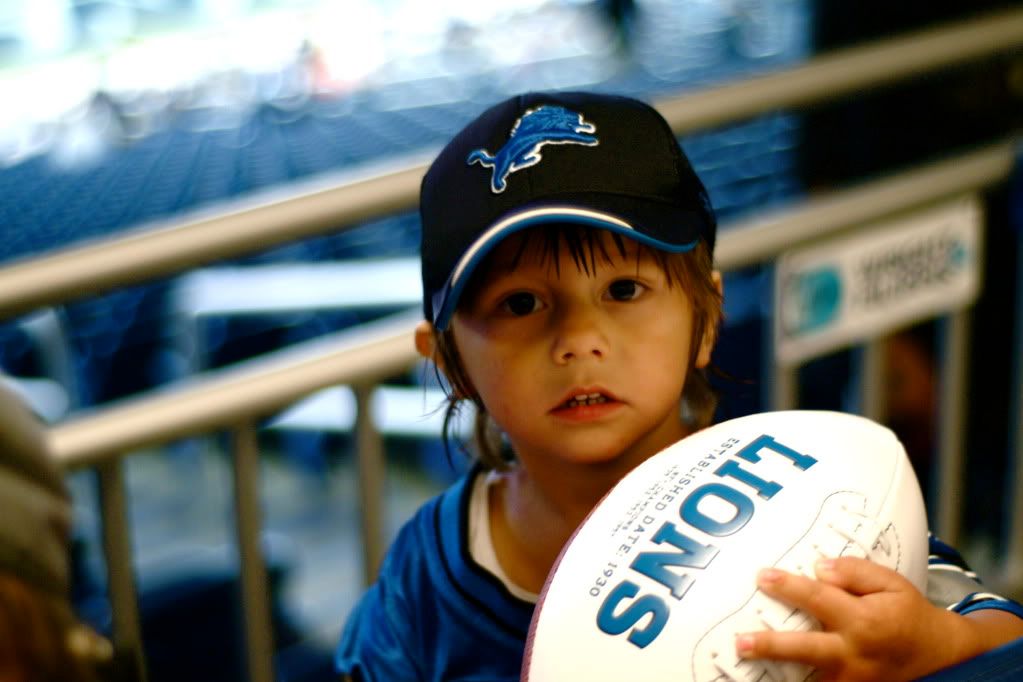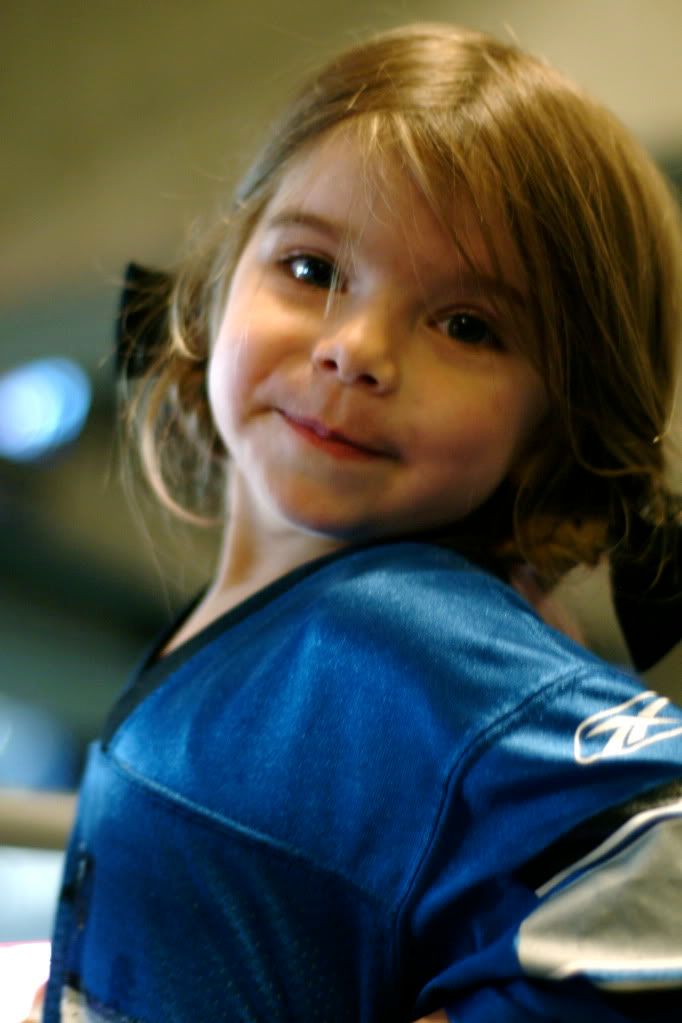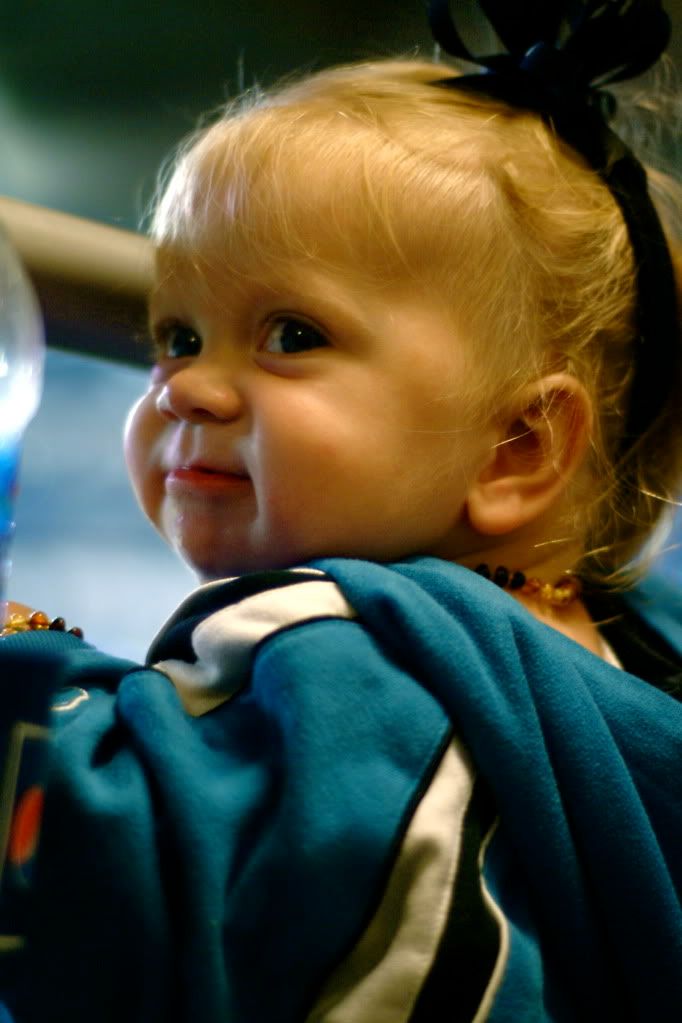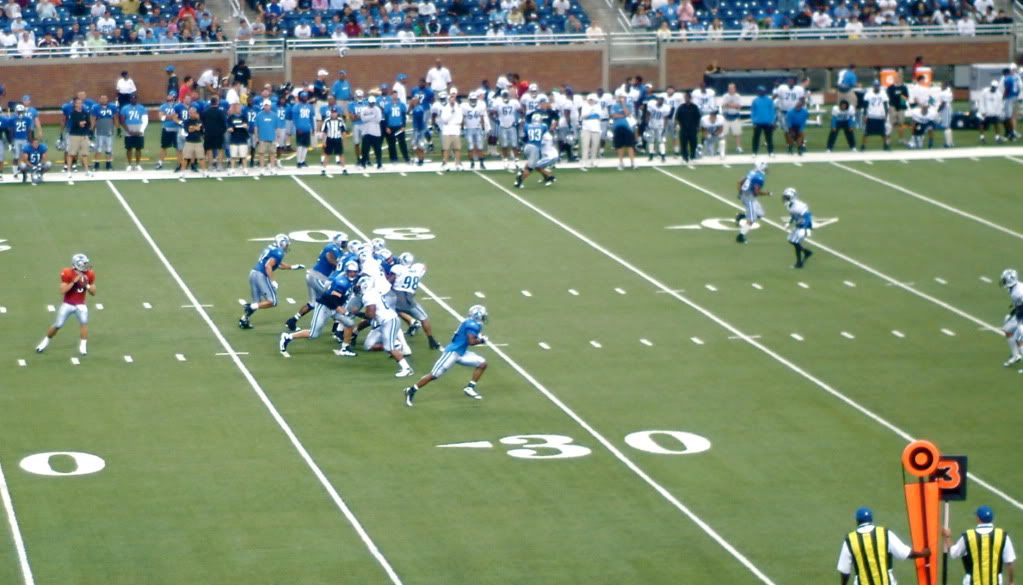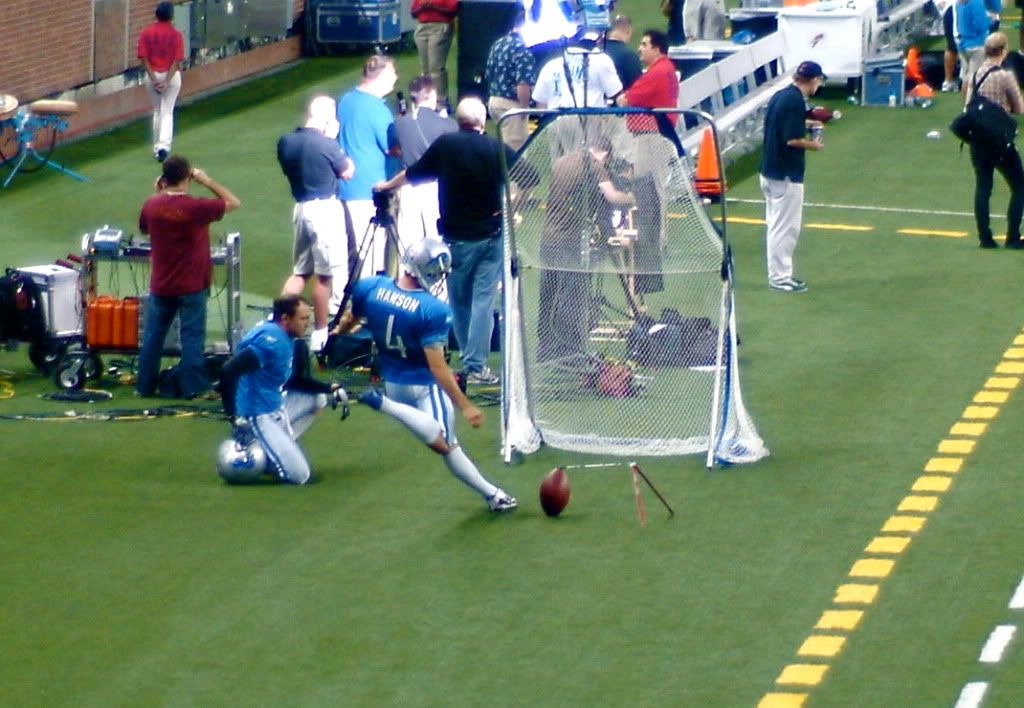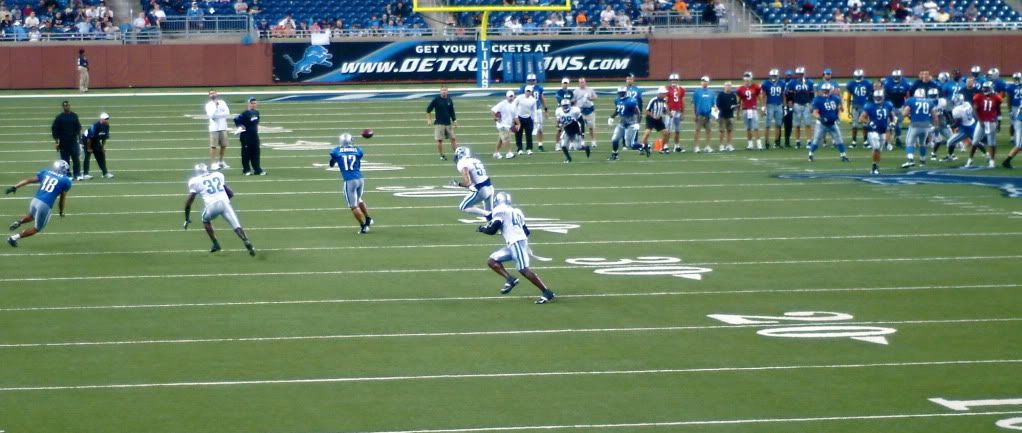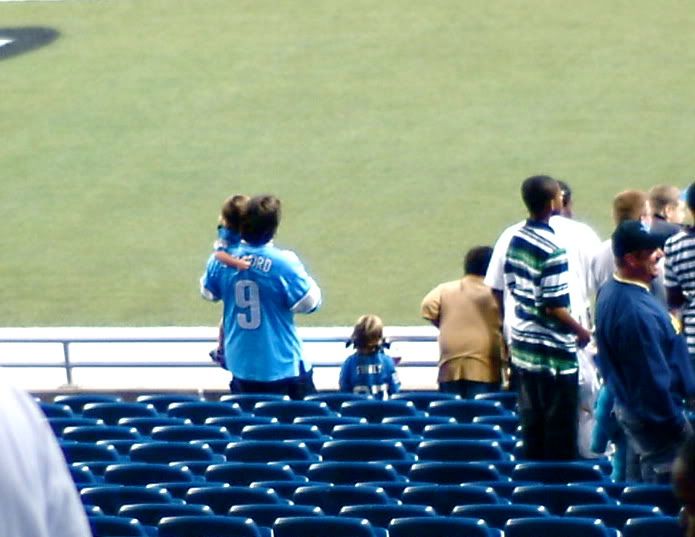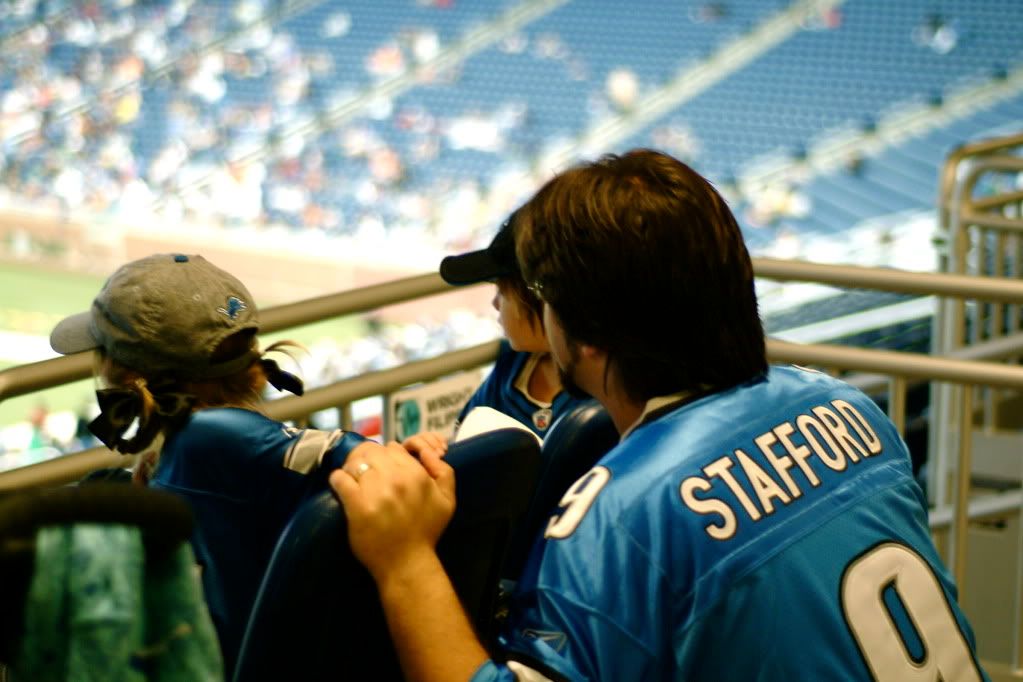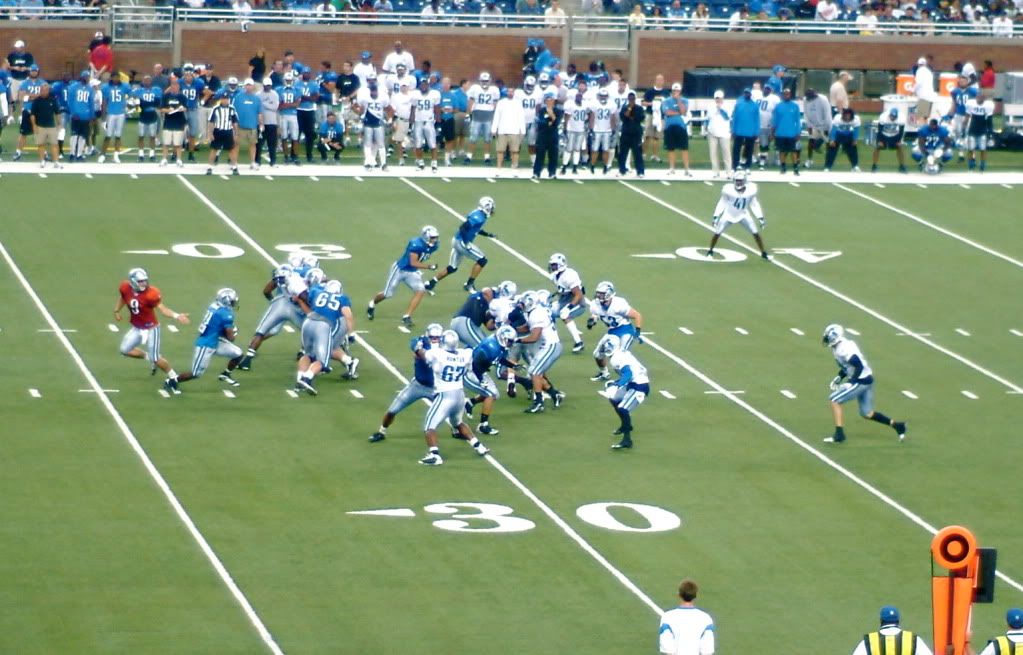the first line of defense?
>> 8.12.2009
It’s a little bit difficult to believe that I’m about to write about the desperate, unsettled nature of the Lions’ defensive line. After all, it was just three years ago that the Lions hired Rod Marinelli—one of the NFL’s top defensive line coaches, and reputed leaguewide to be a brilliant teacher and motivator. He was going to revamp the Lions’ perennially toothless defense, and leading the way would be a Tampa-like front four, our very own Warren Sapp, Booger McFarland, Simeon Rice and Greg Spires to brutalize quarterbacks with.
The plan was, our fierce, fast, athletic line would crash through the gaps, and terrorize opposing quarterbacks. Since the D-line would be so dominant, blitzing would rarely be required; our small, fast linebackers could park in short zones and deny the offense the short passing game. With the terrorizing defensive line up front, and the blanketing zone behind, the Lions’ defense was going to be a nightmare for opposing offensive coordinators.
Yes, well. We knew things weren’t quite going to go to plan when Marinelli’s “top priority” was to sign Kalimba Edwards to a massive five-year extension, based on an Avril-esque rookie season and three years of groin injuries. This started a chain of events—bad signings, draft misses, Marinelli “I’ll coach him up” hubris, trades, and injuries--that left the Lions’ defensive line in its current state: a guy who couldn’t even make the Packers’ camp roster now has “the inside track” on starting at left end.
There was an incredible kids’ show on PBS when I was small called “Square One TV”. Famous for its nonstop U-of-M football in-jokes, the show was somewhere between Sesame Street, a sketch comedy show, and a cartoon—all with math as the focus. The latter half of each episode would feature “Mathnet”, a Dragnet spoof that followed the adventures of two detectives who would solve crimes with math. Often, when they were completely flummoxed, with several conflicting leads, they would “play ‘What Do We Know?’”, and the answers would reveal themselves. It’s played like this:
- We know that Grady Jackson is listed at 6’-2”, 345#. We know he’s a natural wide-bodied, two-gap run-stuffing defensive tackle, of which the Lions’ staff would love to have two in the center of their defensive line. We know he’s 36 years old, and will likely only see action in running situations, i.e., first down and second-and-short. Despite being limited to 15-25 snaps a game, Gunther Cunningham admits that “when you get him in there, everything else goes good.” We know he will likely be (unjustly) suspended for the first four games.
- We know that Chuck Darby is listed at 6’-0”, 297#. We know that he’s a natural one-gap run-stuffer, blessed with an incredible motor, big heart, and not much else. Darby is an overachiever who plays at his absolute limit every second he’s on the field, but he—like Jackson—is getting up there in years (33), and is best suited for running down duty only.
- We know that Landon Cohen is listed at 6’-3”, 274#--though he says he was up to 285 last year, and weighed in to training camp at 302. We know the Lions drafted him in the seventh round of the 2008 draft. We know he did an absolutely astonishing 50 reps of 225 pounds on the bench press at the outset of training camp—for comparison, B.J. Raji only mustered 33 at the combine this year. We know Tom Kowalski reported that he’s been making a splash at camp.
- We know that Andre Fluellen is listed at 6’-2”, 296#. We know he’s an athletically gifted 2008 third-round pick. We know he played at both DT and LE last season, and, according to the official site, allowed only 1.74 yards per play directed at him his rookie season. We have absolutely no clue where the official site got that stat from, how it’s derived, or where we could get it for more players, but we sure wish we knew. We also have no word on his camp performance to date.
- We know that Sammie Hill is listed at 6’-4”, 329#. We know he was drafted out of tiny Stillman College in the fourth round of this April’s draft. We know he’s raw and unpolished, but has the physical tools to remind Gunther Cunningham of Albert Haynesworth. We know his technique and conditioning are a long way from being ready for the big leagues. We know he was drafted to play Major League Baseball. We know he is very impressed by hotel rooms (the famous YouTube video of him and fellow RRA clients doing the “Cribs” thing at their agent-supplied hotel room has apparently been taken down).
- We know that Shaun Smith is listed at 6’-2”, 325#, and has been a moderately effective two-gap DT and DE in the Browns’ 3-4. We know he was on the outs in Cleveland for motivation problems—motivation problems paired with a penchant for mouthing off to the media. We know that immediately after signing, he told the Detroit media that ex-Lions DT Shaun Rogers would love to come back to Detroit. We know The Grandmaster thinks Smith’s talents fit the Lions’ needs.
- We know that Orien Harris is listed at 6’-3”, 300#, we know he’s a high-motor guy, and has been on six different rosters in his four years in the league. We know the Lions’ brass thinks he had a better chance of making the roster than Ronald Curry.
- We know that there’s no way the Lions keep eight defensive tackles on the roster, so
John Gill won’t make the team.UPDATE! About an hour after I posted this, John Gill was released. I apologize to Mr. Gill if I influenced the Lions staff in any way. - We know that Cliff Avril is listed at 6’-3”, 253#, though he reported to camp at a lean 260. We know he’s an explosive edge rusher who led all rookies in sacks last season, in less than half a season’s work. We know he played mostly outside linebacker at Purdue; the Lions were one of the few teams who saw him as a full-time defensive end. We know he’s a prototypical 3-4 ROLB, a little bit light for a prototypical 4-3 RE, and probably ten or fifteen pounds shy of the ideal for Schwartz and Cunningham’s new scheme.
- We know that Dewayne White is listed at 6’-2”, 273#. We know he was effective in spot duty as a pass rusher in Tampa Bay, and we know that—when healthy—he’s been an effective pass rusher here. We know he matches the ideal body type and game for a RE in the Lions’ new system. We know he’s not as effective at rushing the passer from the LE spot, and isn’t the run-stuffer an LE should be.
- We know that Jared DeVries is out for the season.
- We know that Ikaika Alama-Francis is listed at 6’-5”, 280#, but that he’s bulked up to 292 in anticipation of switching to tackle. We know he was a 2007 second-round pick. We know former NFL head coach Jerry Glanville called him the most talented defensive lineman he’d coached. We know that with the injury to DeVries, “Five-O” is back at LE.
- We know that Jason Hunter is listed at 6’-4”, 271#. We know that he matches the ideal body profile of a DE in Schwartz and Cunningham’s new scheme. We know he had a promising first few years in Green Bay--including being their best special teams tackler--but that he had no place in their new 3-4 alignment. We know he has the “inside track” at taking over DeVries’s starting gig.
- We know that Sean Conover is listed at 6’-5”, 275#, and also fits the physical mold of a Lions DE. We know he was acquired by the Titans as a rookie free agent, but after two seasons of semi-successful spot duty, he was released. We know he then kicked off a practice squad tour: the Ravens, Falcons, and Jets all had spots on their practice squads or reserve list for him in 2008.
- We know that Ryan Kees is 6’-6”, 275#, and also fits the physical mold of a Lions DE. We know that he tore it up at D-II Saint Cloud State.
In true Mathnet style, let’s look for the emergent patterns. One is obvious: we see that every defensive end the Lions have acquired this offseason goes around 6’-5” and is 270-275 pounds. This is the body type the Lions would like to see two of set wide, bracing the offensive tackles on either side. Two ends built like this can set a very hard edge, denying running backs the outside, denying the pitch, disrupting the screen. Setting these strong ends out wide will force the running backs up the middle.
Speaking of the middle, another pattern emerges here: with Grady Jackson, Sammie Hill, Shaun Smith, and Orien Harris, every defensive tackle the Lions have acquired has been a natural two-gap run stuffer, with a big, wide body. According to Schwartz, the Lions still use a one-gap responsibility system, but instead of trying to ‘get skinny’ and blast up those gaps with a leading shoulder, the Lions are now squaring up to the gaps, filling them, and then shedding blockers.
According to Nick Cotsonika and Carlos Monarrez of the Free Press, both Jason Hunter and Cliff Avril have been seeing time at both ends, but DeWayne White appears fixed at the right end. This makes sense; White is a productive veteran who perfectly fits the mold of the new right end. It will be between the gifted-but-too-small Avril and the bigger-but-less-explosive Hunter for the starting LE spot—but keep in mind, with the high levels of blitz, and extreme situalization of the defense, no matter what the depth chart looks like, Avril will see a “starter”-like snap count. Ikaika Alama-Francis would have been the perfect left end coming out of college, but he’s about thirty pounds too heavy now; I have no idea if they’ll have him lose weight, or what. He may challenge Hunter for first- and second-down LE reps.
When Grady Jackson was signed, the prevailing wisdom amongst fans was that he’s be the starting nose tackle and Chuck Darby would be the #2. However, basing this on little more than hunch, I think the Lions will play them side-by-side on running downs. Darby’s simply too small to play the nose tackle role in this defense. Besides, with the employment of the 3-3-5 nickel defense, there may only be two tackles out there on running downs anyway. If you have two natural run stuffers who aren’t much good for anything else, and only have 15-25 snaps a game in them, why not use them together for 15-25 ‘1st-and-10’s and ‘2nd-and-short’s? I think Shaun Smith or Sammie Hill will be the #2 ‘bigger’ tackle; Smith if he shuts his mouth and plays well consistently, Hill if he can get his conditioning where it needs to be. Landon Cohen’s had an incredible camp, and Andre Fluellen really impressed me with his inside/outside athleticism late last season. I still think the best place for “Five-O” is at the under tackle spot.
So, where does this leave us? I decided to chart it out, based on everything we that we know, plus a little good old-fashioned hunchwork:
| Alignment | LE | UT | NT | RE |
| Base 4-3 (run) | Hunter/Francis | Darby | Jackson | White/Hunter |
| Base 4-3 (pass) | Avril/Hunter | Cohen/Fluellen | Smith/Hill | White/Avril |
| Nickel 4-3 | Avril/White | Cohen/Fluellen/ Francis | Smith/Hill/ Francis | Avril/Peterson |
| Nickel 3-3 | Francis/Fluellen/Cohen | -- | Smith/Hill | White/Francis/ Fluellen |


